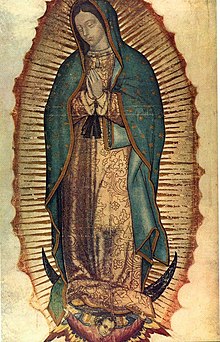19°29′04″N 99°07′02″W / 19.48444°N 99.11722°W
Our Lady of Guadalupe
| |
|---|---|
 | |
| Location | Tepeyac Hill, Mexico City |
| Date | December 9–12, 1531 O.S. (December 19–22, 1531 N.S.) |
| Witness | |
| Type | Marian apparition |
| Approval | October 12, 1895 (canonical coronation granted by Pope Leo XIII) |
| Venerated in | |
| Shrine | Basilica of Our Lady of Guadalupe, Tepeyac Hill, Mexico City, Mexico |
| Patronage |
|
| Attributes | A pregnant woman, eyes downcast, hands clasped in prayer, clothed in a pink tunic robe covered by a cerulean mantle with a black sash, emblazoned with eight-point stars; eclipsing a blazing sun while standing atop a darkened crescent moon, a cherubic angel carrying her train |
| Feast day | December 12 |

Our Lady of Guadalupe (Spanish: Nuestra Señora de Guadalupe), also known as the Virgin of Guadalupe (Spanish: Virgen de Guadalupe), is a Catholic title of Mary, mother of Jesus associated with a series of four Marian apparitions to a Mexican peasant named Juan Diego and one to his uncle, Juan Bernardino, which are believed to have occurred in December 1531, when the Mexican territories were part of the Spanish Empire.
A venerated image on a cloak (tilmahtli) associated with the apparition is enshrined in the Basilica of Our Lady of Guadalupe in Mexico City. Pope Leo XIII granted the image a decree of canonical coronation on February 8, 1887, and it was pontifically crowned on October 12, 1895. The basilica is the most-visited Catholic shrine in the world, and the world's third most-visited sacred site.[2][3]
- ^ "Iglesia Episcopal Anglicana de Chile". Instagram. Retrieved December 13, 2023.
- ^ "World's Most-Visited Sacred Sites", Travel and Leisure, January 2012
- ^ ""Shrine of Guadalupe Most Popular in the World", Zenit, June 13, 1999". Archived from the original on May 7, 2016. Retrieved June 12, 2009.